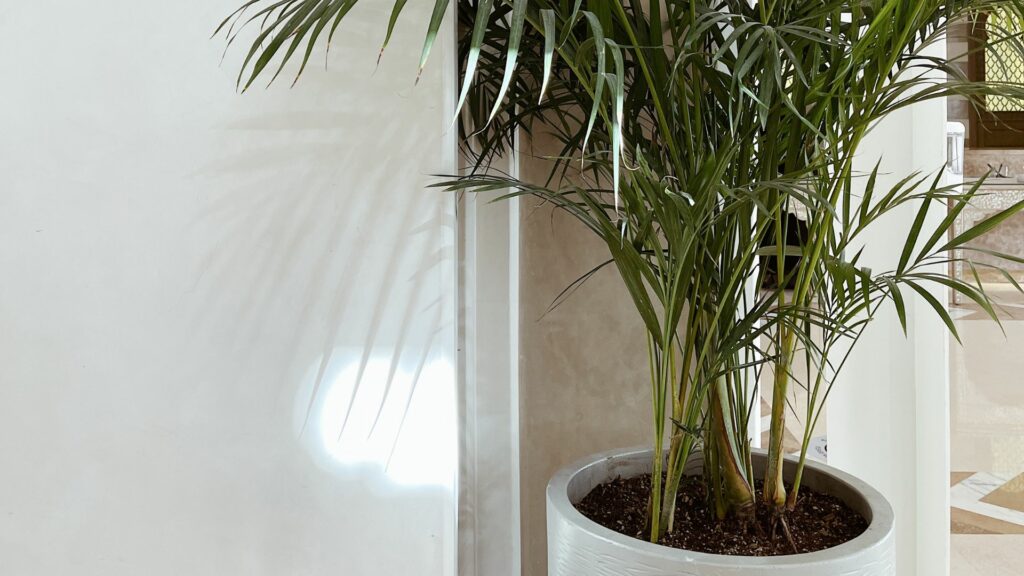Palms are ideal indoor trees that add a relaxing, natural atmosphere to interior spaces. Though the plants are hardy and easy to maintain, they will not thrive unless cared for correctly. So, how does one maximize the health, vigor, and beauty of palms growing indoors?
When caring for indoor palm trees, provide them with bright indirect light, mild temperatures, high humidity, well-aerated soil with a neutral or slightly acidic pH, and moderate amounts of water and all-purpose fertilizer. Monitoring for pests and diseases is also crucial for the plants to thrive.
Palm trees have similar care requirements to most common houseplants, but there are some principles and rules that you should know if you want to maximize the plants’ health and beauty. Fortunately, this guide provides the essential information for successful indoor palm care.
How to Care for Indoor Palm Trees

Caring for palm trees (Arecaceae family) growing in interior space is relatively simple. There are more than 200 genera in the family, with each species having slightly different growing requirements depending on their natural habitats. Most of the plants are from tropical and subtropical regions, though some occur in arid areas.
Despite this diversity, most indoor palms thrive with the following conditions and maintenance practices.
The plants prefer sunny environments, so it is usually necessary to position the plants in a place that receives bright but indirect sunlight. Certain species tolerate higher light levels and might grow well in a room with exposure to direct sunlight for a few hours each day.
The air in the growing area should not be too dry. Inadequate relative humidity causes the tips of the fronds to turn brown. It is also crucial that the plants receive fresh air, so the growing area must have reasonable air circulation.
Palm trees tolerate a broad range of temperatures but need mild to warm temperatures to grow with vigor and produce dense, green foliage.
The soil structure must be loose, fluffy, quick-draining, and highly aerated. It is necessary to apply small amounts of water regularly in the growing season, and infrequent watering applications during the winter (when the plants are dormant). The same rule applies to feeding. Low to medium doses of fertilizer are applied during summer, and little or no nutrients are added during the dormant months.
Light: Indirect and Bright
Giving Arecaceae plants the appropriate amount and intensity of light is critical for maintaining their health and beauty.
It is advisable to position the plants in locations where they can receive bright but indirect light. Rooms that face south or east are optimal (if you’re in the Northern Hemisphere).
While palms can survive in low-light conditions, they will generally exhibit slow or stunted growth. If you have a dimly lit interior space, choose tropical or sub-tropical Arecaceae species. These species grow naturally under forest canopies so they are more capable of tolerating shaded conditions than species from arid regions.
Examples of palm trees that tolerate low light levels include:
- Love or parlor palm (Chamaedorea elegans)
- Lady palm (Rhapis excelsa)
- Kentia palm (Howea forsteriana)
- Bamboo palm (Chamaedorea seifrizii)
- Ponytail palm (Beaucarnea recurvata)
It is beneficial to rotate the plants regularly so they receive even light on all sides. The general recommendation is to turn the plants 45 degrees every one to two weeks. Neglecting this task results in asymmetrical growth and an increased risk of fungal disease on the shaded side of the plant.
Soil Conditions
Palm trees grow well in a wide range of soil conditions, but if you want the plants to thrive, the soil should have optimal structure and fertility levels.
The soil structure must be light and loose to allow sufficient water drainage and aeration. If the soil mix is dense and easily water-logged (for example, if it has a high proportion of fine clay particles), the palm’s roots might suffocate and rot.
Here is an excellent mix to provide the ideal soil structure:
- 1/3 potting soil (as a base)
- 1/3 coco coir or peat moss (for water retention)
- 1/3 perlite or coarse sand (for drainage)
Palms generally prefer a neutral soil pH range between 6.0 and 8.0. It is worth noting that some species thrive in slightly acidic soil with a pH as low as 5.0.
Indoor palms are not heavy feeders, but they benefit from having some decomposed organic matter in their growing media. Since the plants are grown in containers with limited available nutrients, adding compost to the grow media (at 10% to 15% of the mix) helps to maintain their health, vigor, and greenness.
Fertilizing Regime
While compost can provide a portion of the required nutrients, the trees grow most lusciously when they receive applications of fertilizer.
Types of fertilizer: In general, you can feed the plants a balanced, all-purpose NPK fertilizer (such as 3-1-2). It is preferable, however, to apply fertilizer that is high in potassium and magnesium. Horticulturists at the University of Florida recommend a specific nutrient blend for palm trees which is 8-0-12-4 (the last number represents magnesium).
Giving the plants a fertilizer that contains micro-nutrients (such as liquid kelp products) is also crucial to provide plants with comprehensive nutrition.
A useful tip is that palms prefer to receive primary macronutrients (nitrogen, phosphorous, potassium) and secondary macronutrients (like magnesium) in solid, granule form. Feed the plants micronutrients that are in liquid form.
Top-dressing the soil with high-quality, microbe-rich organic compost also produces excellent results.
Feeding schedule: The feeding regime changes depending on the time of year. In the summer growing season, the plants require regular fertilizer applications. For example, liquid fertilizer products should be applied once or twice a month, while granulated fertilizers can be applied once or twice over the growing season.
If you’re growing acid-loving species (such as the majesty palm), note that nitrogen leaches rapidly from acidic soil. In soil with a pH below 6.0, the plants will likely require more frequent feeding to ensure the plants have adequate sustenance.
During the cooler winter months, Arecaceae species become dormant, so you don’t need to feed them (unless they show signs of significant nutrient deficiencies).
Watering Regime
Giving indoor palm trees the appropriate quantity of water is fundamental to their health, growth rate, and appearance. The aim is to keep the soil in the container evenly and consistently moist while ensuring the growing media is not wet!
The water needs of these plants are highest during the summer growing season. During this period, the plants require medium to high amounts of water, applied two or three times per week (depending on the ambient temperature and humidity levels in the surrounding indoor environment). Check the soil regularly to monitor moisture levels at this time of year.
During winter dormancy, palms don’t require much water. You might only need to water their container once a month in the cool season. Monitor the soil moisture to assess when and how much to water the plants.
Air Circulation, Temperature and Humidity
Maintaining optimal air conditions in the indoor growing area is a critical aspect of palm tree care. The trees need air circulation, but always make sure they are not exposed to drafts.
Direct exposure to strong air movement desiccates their foliage because Arecaceae species prefer moderate to high humidity (especially the subtropical and tropical varieties). Ideally, the relative humidity levels in the room should stay above 50% for indoor palms to thrive.
The plants prefer mild air temperatures due to the climates of their natural habitats. They are happiest when you keep the interior space within the range of between 60F and 80F (during the night and day respectively). This range corresponds with typical ambient room temperatures, so special techniques or equipment are not required.
Pest and Disease Prevention
Palm trees are hardy and are unlikely to experience significant pest and disease problems, especially if you maintain optimal growing conditions. The plants are, however, susceptible to certain pests and diseases if they receive improper care, for example, extreme fluctuations in temperature, humidity, or soil moisture levels.
Prevention is the most effective strategy, so concentrate on providing ideal growing conditions and perform routine monitoring to identify early signs of insect or disease pressure.
Some of the most common pests that infest and damage these trees include:
- Mites (such as the red palm mite)
- Mealy bugs
Diseases that frequently afflict Arecaceae trees are:
- Pink rot
- Fusarium wilt
- Diamond scale
Pruning the fronds is frequently the cause of disease as the cut creates a vector for pathogens to infect the tree. For this reason, try to avoid unnecessary pruning. If you do prune some leaves, make sure to use clean, sharp tools and only remove fronds that are already dead.
Final Thoughts
Palm trees are exquisite ornamental plants for indoor spaces that are easy to care for. Providing well-aerated and fast-draining soil, mild temperatures, and adequate humidity and implementing correct watering and feeding practices will ensure the plants thrive.

